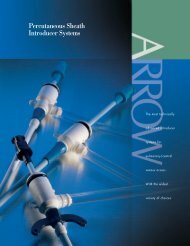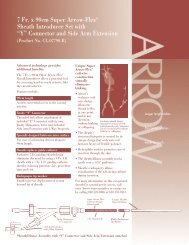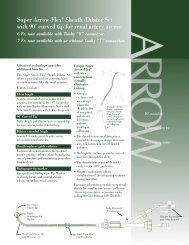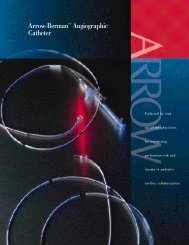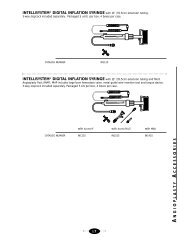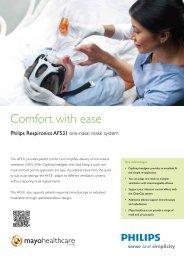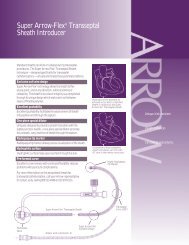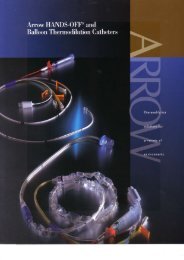Cathryn Murphy - Mayo Healthcare
Cathryn Murphy - Mayo Healthcare
Cathryn Murphy - Mayo Healthcare
You also want an ePaper? Increase the reach of your titles
YUMPU automatically turns print PDFs into web optimized ePapers that Google loves.
Objectives• Highlight the significance of this paper• Provide an overview of the key pointsmade in the paper and detail methods• Suggest ways in which clinicians may usethis paper in guiding IV practice in theirclinical settings.
Evolving Thinking on Connectors andCR-BSILack ofeducationTortuous FluidPathPoor aseptictechniqueHub DesignValve design &internal parts
Evolving Thinking on Connectors andNo Risk of CR-BSIStaffing changesimpact ratesoverallIf this is such a problem why do we seeso few cases and so few reports?Aseptic techniquevaried betweenstudy periodsCompliance withScrub The HubRecommendationsis low.User techniquesare inconsistent
The Significance of This Paper
Significance of This Paper• Additional evidence of negative patientoutcomes associated with mechanical valvetechnology• Largest study and first multi-national study• Increases noted in a range of clinical settings• Both +ve and –ve pressure valves areimplicated
Significance of This Paper• Bloodstream infection prevention practices andsurveillance methods were studied and noanomalies reported that may have affectedreported increases• Raises questions about the likelihood ofadditional problems in other countries whereMVs are commonly used• Expands the list of mechanical valves nowimplicated
Key Points
Background• Prior to this paper there have been 4 outbreaks temporallyassociated with positive-pressure mechanical valve (MV) use:– Maragakis –from CLAVE to Smartsite Plus – Salgado -Smartsite – Rupp – Smartsite Plus – Field – CLAVE & CLC 2000 • The true impact of mechanical valves remains undefined• This paper included reports of increased healthcare careassociatedcatheter-related bloodstream infections (HA-BSIs)associated with negative and positive MVs• This is the first multi-country paper
Participant Details
Patients and Methods• Quasi-experimental design was used to identify additionalinstitutions– This design is used when a subjects cannot be randomly assigned totreatment conditions. The researcher does manipulate theindependent variable (MV) and exercises certain controls to enhancethe internal validity (the degree of inference that MVs rather thanuncontrolled factors caused the observed effects) of the results.• Forums, scientific meetings were used to identify other casesas there were no international or national networks ormechanisms available
Patients and MethodsData Collection and Quality• All data had been obtained before the focus group meetings soindependent of those proceedings– Active• Actively identify infections using multiple data sources– Patient-based• Identify individual risk factors and patient care proceduresin addition to laboratory data– Prospective• Monitor patients for infection during their hospitalizationwhen possible
Sources of Data for Finding CLABSI• Microbiology reports• Infection control rounds on monitored units• Pharmacy reports for antimicrobial use• Networking with nursing staff• Temperature chart• List of patients with central linesReproduced fromhttp://www.cdc.gov/nhsn/PDFs/slides/NHSN_training_CLABSI_revised_April_08_Slides.pdf Accessed01/10/10
How CLABSI Denominator Data for ICUWas Collected• At the same time each day, counted• –# patients (i.e., patient days)• –# patients with one or more central lines(i.e., central line-days)• Enter the totals within 30 days of the end ofthe month
Collection of Denominator Data –CVCDays
Patients and Methods:Calculating Rate To DetermineInfections per 1000 CVC Days
Patients and Methods: Study Periods• The pre-MV-NC, MV-NC and post-MV-NCs are clearlydefined, differentiated and identified.– Pre-MV-NC –(Range 6-24 months, median 18, mean 15.6)– MV-NC –(Range 11-39 months, median 12, mean 18.8)– Post MV-NCs –(Range 5-18 months, median 8, mean 10.3)• Australian hospitals did not provide data onpost-MV device use• HA-BSI prevention practices were assessed tocontrol for confounders
Results• Prevention practices were similar for all hospitals• During or between the periods there were nochanges in:– Surveillance methods– Clinical practices– Patient populations or culturing– Nurse to patient ratios or infection prevention staff
Results• 3 MVs implicated:– Clearlink (Baxter) – negative pressure – 2 UShospitals– Ultrasite (B. Braun) – positive pressure 1 US hosp– Smartsite (CareFusion) – positive pressure – 2Aussie hospitals
How Are The Results Presented?Hospitals N=5US N=3Australia N=2All ICUs and Wards thatintroduced MVsBSIs increased from 3.8 to6.8*(Extra 3 BSIs every 1000CVC days)Hospitals that reverted to SSN=3At each facility the HA-BSI ratesdecreased to below the MV BSIrate . In 2 of the facilities ICUsand the third facility's wardsthe reduction was statisticallysignificant.ICUs that reverted to SS(N=14)BSIs decreased from 9.5 to5.8* (P
Results
Interpreting The Results• Statistical significance: Statistical methods allow anestimate to be made of the probability of theobserved or greater degree of association betweenfactors. From this estimate, in a sample of given size,the statistical "significance" of a result can be stated.A number that expresses the probability that theresult of a given experiment or study could not haveoccurred purely by chance.University of Ottowa. McLaughlin Center For Population Health Risk Assessment. http://www.rfcom.ca/glossary/index.shtml Accessed 7thJanuary 2010
Interpreting The Results• P Value: the probability of observing CR-BSI as extreme ormore extreme than the one actually observed from chancealone• Lets us decide whether to reject or accept the null hypothesis(that there is no increased risk of BSI with needlelessconnector use)• P > 0.05Not significant• P = 0.01 to 0.05 Significant• P = 0.001 to 0.01 Very significant• P < 0.001Extremely significant
ResultsHighly significant increase when I6ICUs introduced MVsHighly significant reduction when I4ICUs MVs were discontinued and SSreintroducedThere are a few other significant results but concentrate on highly significant and larger sample size and trends.
Relative Risk• The ratio of the risk of disease in the exposedgroup (MVs) compared to the risk of disease inthe unexposed group (SS)• Also referred to as Risk Ratio• Values of RR range from 0 to infinity
Relative Risk• Measures the magnitude of the associationbetween the disease among those withexposure (MV) compared to the those withoutthe exposure (SS)• RR = 1, no association• RR > 1, positive association• 0 < RR < 1, negative association
Interpreting The Results• What is a Confidence interval?:– A range of values for a variable ofinterest e.g., a rate, constructed sothat this range has a specifiedprobability of including the true valueof the variable.• What is 95% Confidence Interval?– RR 1.54 (95% CI 1.37 1.74). Thismeans that the estimated risk of BSI inthe ICUs where MVs were in use was1.54, and there is a 95% probabilitythat the "true" risk (if that could beascertained) is within the range 1.37 1.74.University of Ottowa. McLaughlin Center For Population Health Risk Assessment. http://www.rfcom.ca/glossary/index.shtml Accessed 7thJanuary 2010
What Scientific Claims Can We Make FromThis Data?• Temporal relationship has been shown to exist but not clear causation• Temporal refers to the timing of the relationship between a factor (MV)and an outcome (BSI). It is one of the criteria used to assign causality to arelationship.• In this temporal relationship the problem (BSI) appears when exposureoccurs (MVs) and disappears (or does not occur) when the exposure is notpresent• Confounding: The distortion of an apparent effect of an exposure on risk,brought about by the association with other factors that can influence theoutcome.University of Ottowa. McLaughlin Center For Population Health Risk Assessment. http://www.rfcom.ca/glossary/index.shtml Accessed 7thJanuary 2010Jarvis, W. 2010. Personal communication. 10 th January.
Extrapolating The Results• In our study in various settings we know the increased rate of BSIs per 1000CVC days when MVs were introduced.• We also know the decreased rate per 1000 CVC days when MVs wereremoved.• In a 2006 landmark study of 103 ICUs in Michigan, Pronovost reported thatthe mean number of catheter-days per month in an ICU ranged from 4757 to5469.• If we assume that this is the typical number of catheter days in US and AussieICUs hospitals we can estimate excess cases, potential reductions and costs (in$USD) of both• Assume the average increased cost of care for a patient with a CR-BSIs rangesfrom $USD 29-45k per episode.
Estimated Impact on BSIs Per Month if MVsIntroduced or Removed in An ICUMean CVC Days PerMonth as per PronovostStudy (2006)*Estimated Extra ICU BSIsPer Month If MVsIntroduced & AssumingIncrease is 3.4 extra per1000 CVC DaysEstimated Reduction inICU BSIs Per Month If MVsRemoved & SS Introducedand Assuming Reductionis 3.7 fewer per 1000 CVCDays4757 16 185469 19 20*Pronovost, P., D. Needham, et al. (2006). "An Intervention to Decrease Catheter-Related Bloodstream Infections in theICU." The New England Journal of Medicine 355(26): 2725.
EstimatedExtra ICU BSIsPer Month IfMVsIntroduced &AssumingIncrease is3.4 extra per1000 CVCDaysEstimatedAdditionalMonthly Cost@$ USD 29kEstimatedAdditionalMonthly Cost@$ USD 45kEstimatedReduction inICU BSIs PerMonth If MVsRemoved &SS IntroducedandAssumingReduction is3.7 fewer per1000 CVCDaysEstimatedMonthlySaving @$ USD 29kEstimatedMonthlySaving @$ USD 45k16 $464,000 $720, 000 18 $522,000 $810, 00019 $551,000 $855, 000 20 $580,000 $900, 000Pronovost, P., D. Needham, et al. (2006). "An Intervention to Decrease Catheter-Related Bloodstream Infections in theICU." The New England Journal of Medicine 355(26): 2725.
Results• Pathogens attributed to HA-BSI:– Coagulase-negative staphylococci– Staphylococcus aureus– Yeast– Enterococcus– Other gram-negative and gram-positive organisms• ? Indicates that valves (design) susceptible tocontamination and/or inadequate disinfection
Discussion – Unique Aspects• Demonstrates the problem in multiple and differentenvironments (13 wards or units in 4 hospitals, 1entire hospital and in 2 countries)• Reductions noted only when reverted to SS– Largest, comprehensive evaluation of its type– First study to compare types (+ve/-ve & SS)– Systematic evaluation of prevention practices– Evaluated reasons for change– Used focus group methodology
Discussion• Demonstrates that prevention efforts wereequivalent or superior in the MV-use periodsyet increases occurred• Therefore increases cannot be attributed topoor infection control• No hospital achieved rates as low as SS rateswhen MVs were in use
Hypotheses• When MVs are used there is an increased impact ofdeviating from good infection controls• Clinicians may not be aware of the different practicerequirements between MVs• Connection problems, leakage, fluid accumulation• Insufficient or inadequate MV disinfection• Opacity precluding visualisation of flush
Limitations• None explicitly described in the paper but somepossible:– Small sample size;– Self-selection of participants;– Study design weak compared to a RCT– Authors’ consultancy relationship with manufacturerof split-septum technology;– Duplication of previously published data –e.g.Salgado
Ways In Which Clinicians May Use ThisPaper In Guiding IV Practice In TheirClinical Settings.(Including Its Relationship To Existing Guiding Documents andCompetitors’ Current Marketing Claims)
Marschall J, Mermel LA, Classen D, Arias KM, Podgorny K, Anderson DJ, Burstin H, Calfee DP, Coffin SE, Dubberke ER, FraserV, Gerding DN, Griffin FA, Gross P, Kaye KS, Klompas M, Lo E, Nicolle L, Pegues DA, Perl TM, Saint S, Salgado CD, WeinsteinRA, Wise R, Yokoe DS. Strategies to prevent central line-associated bloodstream infections in acute care hospitals. InfectControl Hosp Epidemiol. 2008;29: S22-3 0.
Edgar KJ. Does the evidence support the SHEA-IDSA recommendation on the use of positive-pressuremechanical valves? Infect Control Hosp Epidemiol. 2009 Apr;30(4):402-3; author reply 3-4.
http://wwwn.cdc.gov/publiccomments/comments/guidelines-for-theprevention-of-intravascular-catheter-related-infections.aspx
Current Language As Per CDC Draft• Lines 1077-1079, p.48.– Use a needleless system to access IV tubing. Category1C– When needleless systems are used, the split septumvalve is preferred over the mechanical valve due toincreased risk of. Category II• Optimistic that this language will remainunchanged –public submissions vary in responseto it
Summary• Long awaited publication that provides useful additional tool todraw clinicians’ attention to the temporal relationship betweenuse of MVs and increased CR BSI• The strong aspects of the study are its design, size,multinational component and confirmation of previous studies• Given that this paper is yet another example of the relationshipbetween MVs and CR-BSI as advocates of better patient safetyaround the world we need to ensure that this paper is used inupcoming redrafting of guidance documents locally andinternationally.
Contact DetailsAssociate Professor <strong>Cathryn</strong> <strong>Murphy</strong>Faculty Health Science and MedicineBond UniversityQueenslandManaging Director – Infection Control PlusE-mail: cmurp@icp.au.comwww.icp.au.com



